The Definition of the Derivative | Calculus - Mathematics PDF Download
In the first section of the Limits chapter we saw that the computation of the slope of a tangent line, the instantaneous rate of change of a function, and the instantaneous velocity of an object at x=a all required us to compute the following limit.
We also saw that with a small change of notation this limit could also be written as,
This is such an important limit and it arises in so many places that we give it a name. We call it a derivative. Here is the official definition of the derivative.
Defintion of the Derivative
The derivative of f(x) with respect to x is the function f′(x) and is defined as,
Note that we replaced all the a’s in (1) with x’s to acknowledge the fact that the derivative is really a function as well. We often “read” f′(x) as “f prime of x”.
Let’s compute a couple of derivatives using the definition.
Example 1 Find the derivative of the following function using the definition of the derivative.
f(x) = 2x2 − 16x + 35
Solution:
So, all we really need to do is to plug this function into the definition of the derivative, (2), and do some algebra. While, admittedly, the algebra will get somewhat unpleasant at times, but it’s just algebra so don’t get excited about the fact that we’re now computing derivatives.
First plug the function into the definition of the derivative.
Be careful and make sure that you properly deal with parenthesis when doing the subtracting.
Now, we know from the previous chapter that we can’t just plug in h=0 since this will give us a division by zero error. So, we are going to have to do some work. In this case that means multiplying everything out and distributing the minus sign through on the second term. Doing this gives,
Notice that every term in the numerator that didn’t have an h in it canceled out and we can now factor an h out of the numerator which will cancel against the h in the denominator. After that we can compute the limit.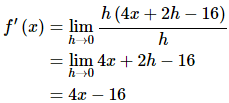
So, the derivative is,
f'(x) = 4x - 16
Example 2 Find the derivative of the following function using the definition of the derivative.
Solution:
This one is going to be a little messier as far as the algebra goes. However, outside of that it will work in exactly the same manner as the previous examples. First, we plug the function into the definition of the derivative,
Note that we changed all the letters in the definition to match up with the given function. Also note that we wrote the fraction a much more compact manner to help us with the work.
As with the first problem we can’t just plug in h=0. So, we will need to simplify things a little. In this case we will need to combine the two terms in the numerator into a single rational expression as follows.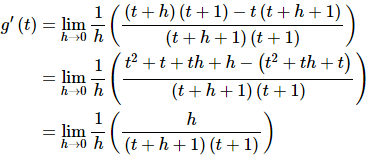
Before finishing this let’s note a couple of things. First, we didn’t multiply out the denominator. Multiplying out the denominator will just overly complicate things so let’s keep it simple. Next, as with the first example, after the simplification we only have terms with h’s in them left in the numerator and so we can now cancel an h out.
So, upon canceling the h we can evaluate the limit and get the derivative.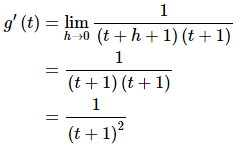
The derivative is then,
Example 3 Find the derivative of the following function using the definition of the derivative.
Solution:
First plug into the definition of the derivative as we’ve done with the previous two examples.
In this problem we’re going to have to rationalize the numerator. You do remember rationalization from an Algebra class right? In an Algebra class you probably only rationalized the denominator, but you can also rationalize numerators. Remember that in rationalizing the numerator (in this case) we multiply both the numerator and denominator by the numerator except we change the sign between the two terms. Here’s the rationalizing work for this problem,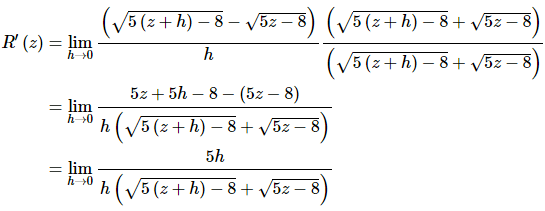
Again, after the simplification we have only h’s left in the numerator. So, cancel the h and evaluate the limit.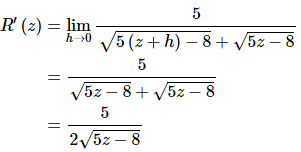
And so we get a derivative of,
Let’s work one more example. This one will be a little different, but it’s got a point that needs to be made.
Example 4 Determine f′(0) for f(x)=|x|.
Solution:
Since this problem is asking for the derivative at a specific point we’ll go ahead and use that in our work. It will make our life easier and that’s always a good thing.
So, plug into the definition and simplify.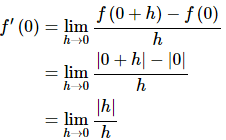
We saw a situation like this back when we were looking at limits at infinity. As in that section we can’t just cancel the h’s. We will have to look at the two one sided limits and recall that


The two one-sided limits are different and so
doesn’t exist. However, this is the limit that gives us the derivative that we’re after.
If the limit doesn’t exist then the derivative doesn’t exist either.
In this example we have finally seen a function for which the derivative doesn’t exist at a point. This is a fact of life that we’ve got to be aware of. Derivatives will not always exist. Note as well that this doesn’t say anything about whether or not the derivative exists anywhere else. In fact, the derivative of the absolute value function exists at every point except the one we just looked at, x=0.
The preceding discussion leads to the following definition.
Definition
A function f(x) is called differentiable at x=a if f′(a) exists and f(x) is called differentiable on an interval if the derivative exists for each point in that interval.
The next theorem shows us a very nice relationship between functions that are continuous and those that are differentiable.
Theorem
If f(x) is differentiable at x=a then f(x) is continuous at x=a.
See the Proof of Various Derivative Formulas section of the Extras chapter to see the proof of this theorem.
Note that this theorem does not work in reverse. Consider f(x)=|x| and take a look at,
So, f(x)=|x| is continuous at x=0 but we’ve just shown above in Example 4 that f(x)=|x| is not differentiable at x=0.
Alternate Notation
Next, we need to discuss some alternate notation for the derivative. The typical derivative notation is the “prime” notation. However, there is another notation that is used on occasion so let’s cover that.
Given a function y=f(x) all of the following are equivalent and represent the derivative of f(x) with respect to x.
Because we also need to evaluate derivatives on occasion we also need a notation for evaluating derivatives when using the fractional notation. So, if we want to evaluate the derivative at x=a all of the following are equivalent.
Note as well that on occasion we will drop the (x) part on the function to simplify the notation somewhat. In these cases the following are equivalent.
f′(x) = f′
As a final note in this section we’ll acknowledge that computing most derivatives directly from the definition is a fairly complex (and sometimes painful) process filled with opportunities to make mistakes. In a couple of sections we’ll start developing formulas and/or properties that will help us to take the derivative of many of the common functions so we won’t need to resort to the definition of the derivative too often.
This does not mean however that it isn’t important to know the definition of the derivative! It is an important definition that we should always know and keep in the back of our minds. It is just something that we’re not going to be working with all that much.
Practice problems: Derivatives
1. Use the definition of the derivative to find the derivative of,
f(x) = 6
Solution:
There really isn’t much to do for this problem other than to plug the function into the definition of the derivative and do a little algebra.
So, the derivative for this function is,
2. Use the definition of the derivative to find the derivative of,
V(t) = 3 − 14t
Solution:
Step 1
First we need to plug the function into the definition of the derivative.
Make sure that you properly evaluate the first function evaluation. This is one of the more common errors that students make with these problems.
Also watch for the parenthesis on the second function evaluation. You are subtracting off the whole function and so you need to make sure that you deal with the minus sign properly. Either put in the parenthesis as we’ve done here or make sure the minus sign get distributed through properly. This is another very common error and one that if you make will often make the problem impossible to complete.
Step 2
Now all that we need to do is some quick algebra and we’ll be done.
The derivative for this function is then,
3. Use the definition of the derivative to find the derivative of,
g(x) = x2
Solution:
Step 1
First we need to plug the function into the definition of the derivative.
Make sure that you properly evaluate the first function evaluation. This is one of the more common errors that students make with these problems.
Step 2
Now all that we need to do is some quick algebra and we’ll be done.
The derivative for this function is then,
4. Use the definition of the derivative to find the derivative of,
Q(t) = 10 + 5t − t2
Solution:
Step 1
First we need to plug the function into the definition of the derivative.
Make sure that you properly evaluate the first function evaluation. This is one of the more common errors that students make with these problems.
Also watch for the parenthesis on the second function evaluation. You are subtracting off the whole function and so you need to make sure that you deal with the minus sign properly. Either put in the parenthesis as we’ve done here or make sure the minus sign get distributed through properly. This is another very common error and one that if you make will often make the problem impossible to complete.
Step 2
Now all that we need to do is some algebra (and it might get a little messy here, but that is somewhat common with these types of problems) and we’ll be done.
The derivative for this function is then,
5. Use the definition of the derivative to find the derivative of,
W(z) = 4z2 − 9z
Solution:
Step 1
First we need to plug the function into the definition of the derivative.
Make sure that you properly evaluate the first function evaluation. This is one of the more common errors that students make with these problems.
Also watch for the parenthesis on the second function evaluation. You are subtracting off the whole function and so you need to make sure that you deal with the minus sign properly. Either put in the parenthesis as we’ve done here or make sure the minus sign get distributed through properly. This is another very common error and one that if you make will often make the problem impossible to complete.
Step 2
Now all that we need to do is some algebra (and it might get a little messy here, but that is somewhat common with these types of problems) and we’ll be done.
The derivative for this function is then,
W′(z) = 8z − 9
6. Use the definition of the derivative to find the derivative of,
f(x) = 2x3 −1
Solution:
Step 1
First we need to plug the function into the definition of the derivative.
Make sure that you properly evaluate the first function evaluation. This is one of the more common errors that students make with these problems.
Also watch for the parenthesis on the second function evaluation. You are subtracting off the whole function and so you need to make sure that you deal with the minus sign properly. Either put in the parenthesis as we’ve done here or make sure the minus sign get distributed through properly. This is another very common error and one that if you make will often make the problem impossible to complete.
Step 2
Now all that we need to do is some algebra (and it might get a little messy here, but that is somewhat common with these types of problems) and we’ll be done.
The derivative for this function is then,
f'(x) = 6x2
7. Use the definition of the derivative to find the derivative of,
g(x) = x3 − 2x2 + x − 1
Solution:
Step 1
First we need to plug the function into the definition of the derivative.
Make sure that you properly evaluate the first function evaluation. This is one of the more common errors that students make with these problems.
Also watch for the parenthesis on the second function evaluation. You are subtracting off the whole function and so you need to make sure that you deal with the minus sign properly. Either put in the parenthesis as we’ve done here or make sure the minus sign get distributed through properly. This is another very common error and one that if you make will often make the problem impossible to complete.
Step 2
Now all that we need to do is some algebra (and it will get a little messy here, but that is somewhat common with these types of problems) and we’ll be done.
The derivative for this function is then,
g′(x) = 3x2 − 4x + 1
8. Use the definition of the derivative to find the derivative of,
Solution:
Step 1
First we need to plug the function into the definition of the derivative.
Make sure that you properly evaluate the first function evaluation. This is one of the more common errors that students make with these problems.
Also note that in order to make the problem a little easier to read rewrote the rational expression in the definition a little bit. This doesn’t need to be done, but will make things a little nicer to look at.
Step 2
Next we need to combine the two rational expressions into a single rational expression.
Step 3
Now all that we need to do is some algebra and we’ll be done.
The derivative for this function is then,
9. Use the definition of the derivative to find the derivative of,
Solution:
Step 1
Make sure that you properly evaluate the first function evaluation. This is one of the more common errors that students make with these problems.
Also note that in order to make the problem a little easier to read rewrote the rational expression in the definition a little bit. This doesn’t need to be done, but will make things a little nicer to look at.
Step 2
Next we need to combine the two rational expressions into a single rational expression.
Step 3
Now all that we need to do is some algebra (and it will get a little messy here, but that is somewhat common with these types of problems) and we’ll be done.
The derivative for this function is then,
10. Use the definition of the derivative to find the derivative of,
Z(t)=√3t−4
Solution:
Step 1
First we need to plug the function into the definition of the derivative.
Make sure that you properly evaluate the first function evaluation. This is one of the more common errors that students make with these problems.
Step 2
Next we need to rationalize the numerator.
Step 3
Now all that we need to do is some algebra (and it will get a little messy here, but that is somewhat common with these types of problems) and we’ll be done.
Be careful when multiplying out the numerator here. It is easy to lose track of the minus sign (or parenthesis for that matter) on the second term. This is a very common mistake that students make.
The derivative for this function is then,
11. Use the definition of the derivative to find the derivative of,
Solution:
Step 1
First we need to plug the function into the definition of the derivative.
Make sure that you properly evaluate the first function evaluation. This is one of the more common errors that students make with these problems.
Step 2
Now all that we need to do is some algebra (and it will get a little messy here, but that is somewhat common with these types of problems) and we’ll be done.
Be careful when multiplying out the numerator here. It is easy to lose track of the minus sign (or parenthesis for that matter) on the second term. This is a very common mistake that students make.
The derivative for this function is then,
|
112 videos|65 docs|3 tests
|
FAQs on The Definition of the Derivative - Calculus - Mathematics
| 1. What is the definition of the derivative in mathematics? |  |
| 2. How is the derivative of a function calculated? |  |
| 3. What is the geometric interpretation of the derivative? |  |
| 4. What are some real-life applications of the derivative? |  |
| 5. Can the derivative be undefined for a function? |  |






















